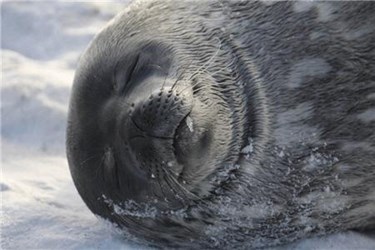Antarctic Wildlife At Risk From Human Derived E. coli

Human sewage disposal in Antarctica presents a risk of introducing non-native bacterial species, specifically E. coli, into endemic Antarctic wildlife, potentially affecting its diversity and evolution, a new research project led by Macquarie University has found.
Funded by an Australian Antarctic Science Grant from the Australian Antarctic Division, the research has detected genes in seals, penguins and invertebrates that are commonly associated with from humans.
At the invitation of the Australian Antarctic Division, Dr Michelle Power from Macquarie University joined the field team at Davis research station to examine how sustained human waste discharge from research stations has the potential to affect the diversity and evolution of native Antarctic microbes, as well as introduce disease to wildlife in the ecosystem.
With most research stations located on the coast of Antarctica, the research provides scientific evidence to support development of improved regulations for human waste disposal.
“Some of the identified strains that we have detected in seals are known to cause disease in humans and birds. Antibiotic resistance genes, currently a major global issue, were discovered in many of the strains we tested. The antibiotic resistance genes were not detected in penguins or seals but were found in an Antarctic shellfish species which filters the water for its food,” said Dr Power.
As part of its commitment to protecting the Antarctic environment, the Australian Antarctic Division undertook a larger study to assess the environmental impact of sewage discharge in Antarctica in 2009/10.
The study included the collection of marine sediments at various coastal points within a 10 kilometre radius, in addition to faecal samples from southern elephant seals, Adelie penguins and Weddell seals. Divers also collected fish, heart urchins, Antarctic soft-shelled clam and conducted detailed surveys of seabed communities as part of the larger study.
Guidelines currently in place for treatment of sewage, established by the Antarctic Treaty system, allow research stations to dispose of untreated sewage directly into the sea – within certain parameters. These include conditions that allow for its rapid dilution and dispersal into the marine environment. Research led by Australian Antarctic Division marine scientist, Dr Jonny Stark, shows that such conditions are unlikely to occur at most Antarctic stations.
Australian Antarctic Division Chief Scientist, Dr Gwen Fenton, said the Division partnered with research and industry to undertake a major engineering project to design and upgrade wastewater treatment for use in Antarctic conditions in response to the combined results of the studies.
“A secondary treatment plant was commissioned at Davis research station in December 2015 and an advanced level treatment plant is due to be installed in 2016/17. This will convert effluent into some of the cleanest water in the world. Both Casey and Mawson research stations have a secondary wastewater treatment plant, with both scheduled for upgrade,” Dr Fenton said.
“With more than 30 nations operating in Antarctica, and around 4000 people living in Antarctic research stations during the summer months, the potential impact of their presence to the surrounding ecosystem cannot be underestimated,” continued Dr Power.
The comprehensive steps taken by Australia to understand and address the environmental impacts of wastewater discharge at Australia’s research stations represent Antarctic best practice, and reinforce Australia’s international leadership in the fields of Antarctic science, operations and environmental management.
Wastewater management is recognised by all national Antarctic programs to be a complex issue, and a wide range of technologies are in use across Antarctic stations. Further steps to prevent the introduction of non-native species and disease will be discussed at the next Antarctic Treaty Consultative Meeting will be held in Chile later this month.
“There is currently no acceptable measure of impact of untreated sewage disposal in Antarctica and I would argue that simple genetic tools can, and should be used to determine the extent of gene pollution across Antarctica,” continued Dr Power.
Journal of Environmental Pollution Escherichia coli out in the cold: Dissemination of human-derived bacteria into the Antarctic microbiome 2016 215: 58-65: doi:10.1016/j.envpol.2016.04.013
Source: Macquarie University
